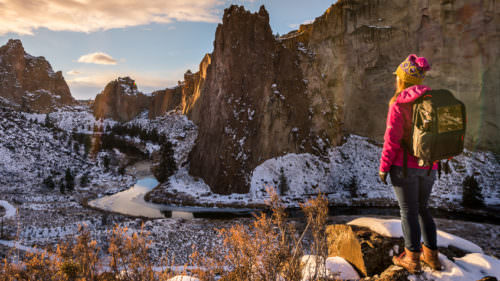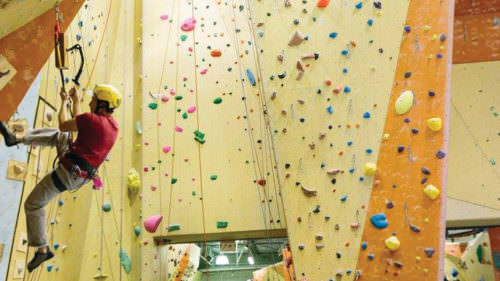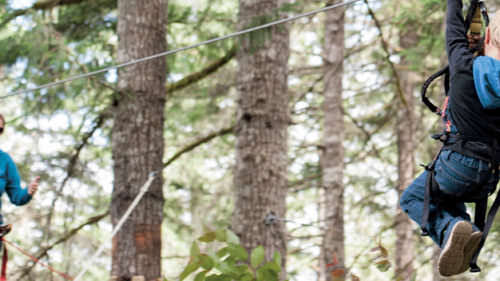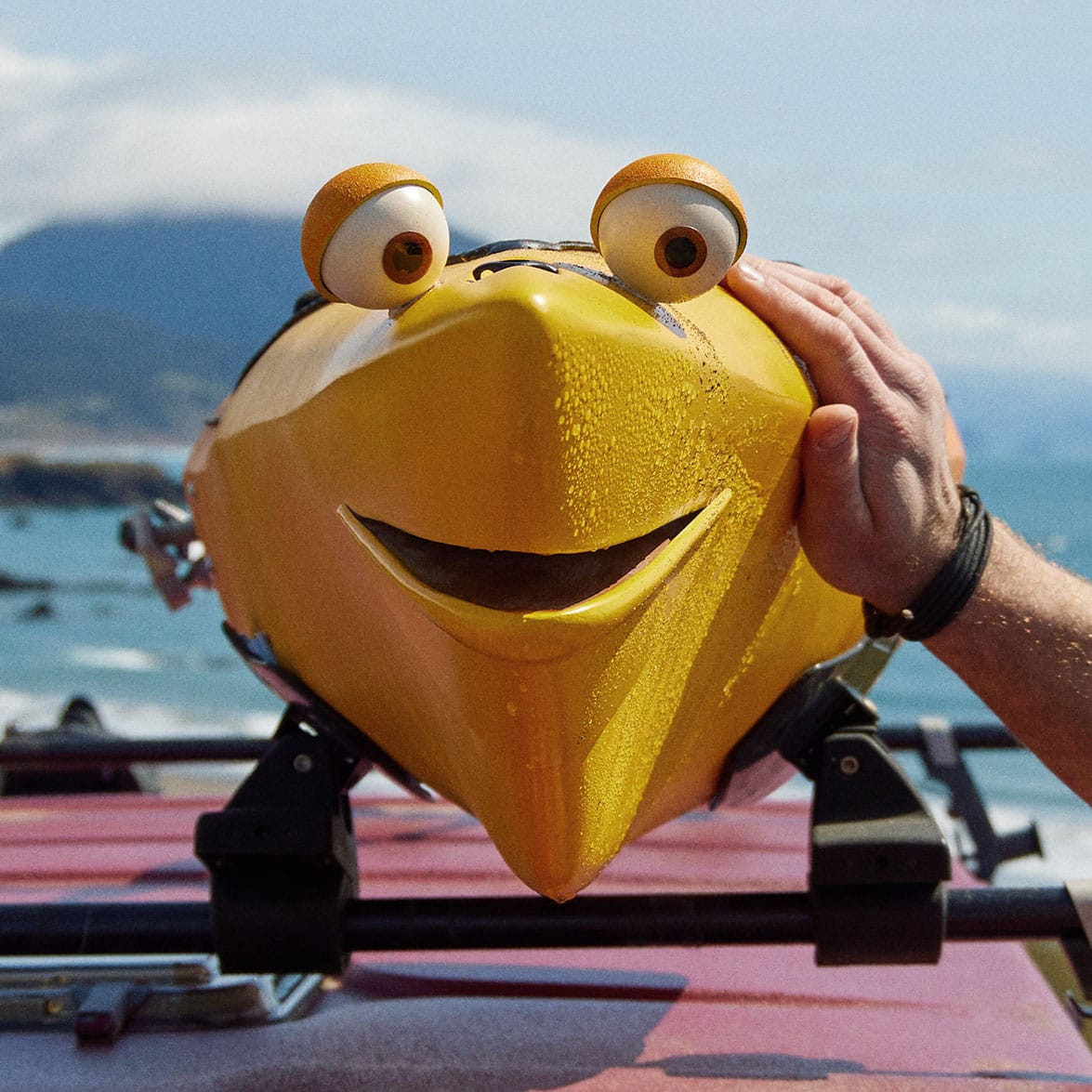Rock climbing in Oregon is as varied as the state’s dramatic landscapes. There’s something for all seasons and all skill levels, from beginner-friendly top-rope climbs in the cool Willamette River Valley to the Lost Lake boulders below Mt. Hood to Spring Mountain’s challenging multi-pitch sport routes outside La Grande. Climbing comes in many forms: simply monkeying around on large boulders (“bouldering”) as well as progressing upward with ropes, harnesses and protective gear. Guides are available, especially in popular spots like Central Oregon’s Smith Rock, but part of the sport’s appeal is discovering new rocks in new environments, so here are nine climbing destinations throughout the state, for everyone from beginners to advanced rockhounds.
Climbing Lingo
Bouldering: The simplest form of climbing, it requires no ropes or harness, just climbing shoes. A “crash pad” comes in handy.
Top-rope: The least technical form of vertical climbing. The route can be accessed from the top so a trained ropes person can set up the rope on fixed anchor points at the top of the route.
Sport: Climber ascends the rock, clipping into established bolts on the route, which act as the protection.
Traditional (“trad”): No bolts on the route. The climber places temporary protection in cracks as she ascends the route. The most technically difficult type of climbing.
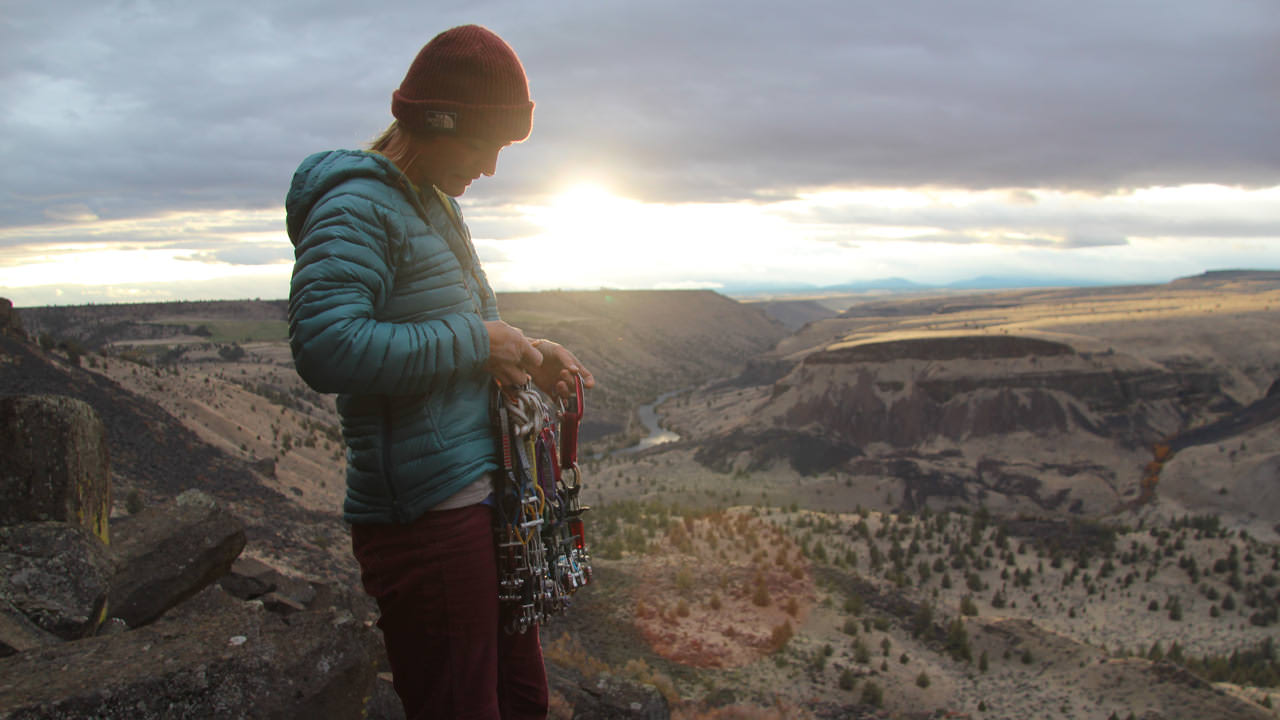
Trout Creek
Outside Madras
Go for: Incredible views and otherworldly geology.
Difficulty: Intermediate and above. Arguably the best crack climbing in the Pacific Northwest; all routes are trad.
Passes and fees: None.
Season: Late summer through fall. Closed from January to April (sometimes as far as August) for Golden Eagle nesting.
A geologic wonder, Trout Creek is one of the most stunning examples of columnar basalt (vertical columns rising like squared-off organ pipes) in the country. The quiet, scenic vibe belies the rock’s challenging climbs, all of which must be ascended via trad techniques of placing protective gear in cracks while climbing. Even the approach to Trout Creek’s climbing area can be a challenge, but the vertical rewards await. Redpoint Climbing in Terrebonne has gear and information. Check the local BLM website for closure updates.
Skinner Butte
Eugene
Go for: Easy-access basalt-columnar climbing with views of downtown Eugene.
Difficulty: Beginner to advanced.
Passes and fees: None.
Season: Year-round accessibility, depending on rain.
This public park rises hundreds of feet above its urban surroundings, close enough to warrant the University of Oregon’s “O” emblem on its side. Forty-foot beginner-to-advanced routes can be top-roped or trad climbed, with boulders for warm-ups or first-timers. With its proximity to thiscollege town, it’s best to come in the morning to avoid the student crowds. Eugene’s Obsidians climbing club offers info online.
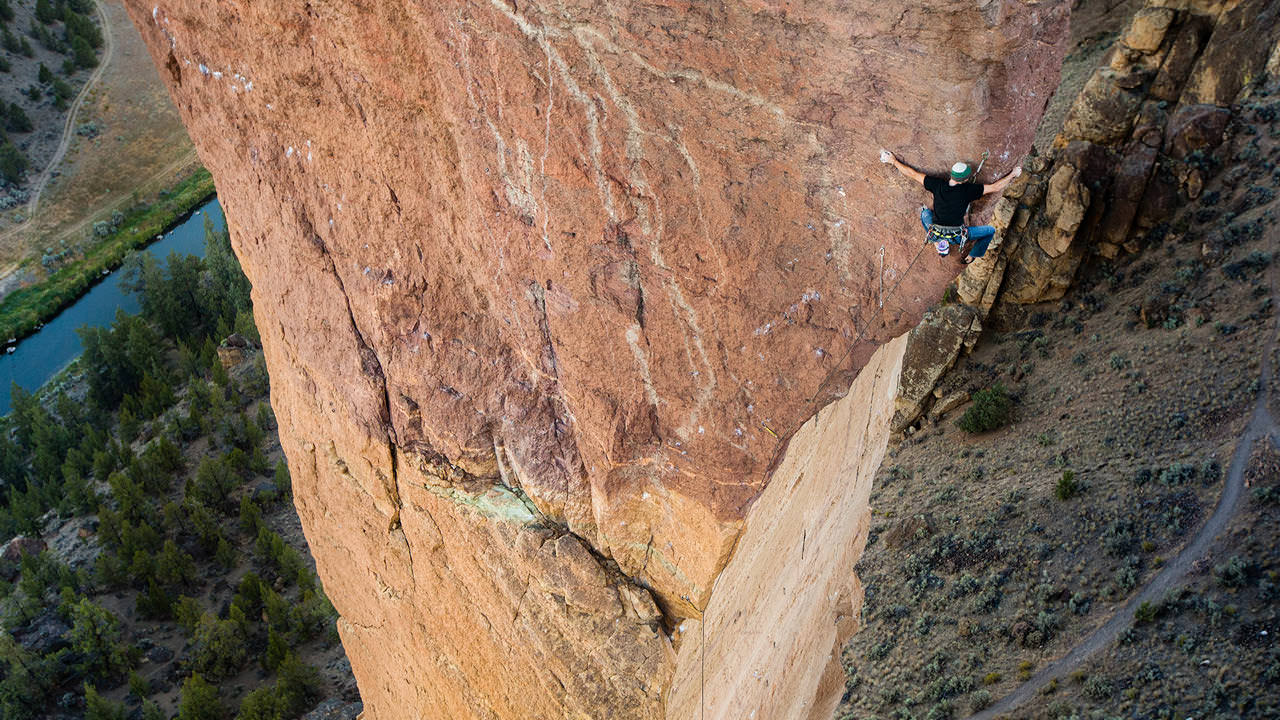
Smith Rock
Outside Terrebonne
Go for: World-class climbing in an epic high-desert setting.
Difficulty: Beginner to advanced.
Passes and fees: $5 day use per vehicle.
Season: Year-round, but we recommend visiting October to April to reduce overcrowding.
Smith Rock is the birthplace of American sport climbing, a legendary park full of big walls, towers, crags and scrambles. Its high-quality rock conditions, wide variety of climbing types and difficulties, and typically ideal weather also make it Oregon’s most popular climbing destination. We suggest visiting midweek or during the off-season (October to April) and hiring a guide to find the most suitable climbs and avoid overcrowding. Inquire with Smith Rock Climbing School about hiring guides.
Bulo Point
Mt. Hood Area
Go for: Secluded climbing at a cool elevation tucked into ponderosa pines.
Difficulty: Beginner to intermediate on clean rock with all options—top-rope, sport and traditional.
Passes and fees: None.
Season: May through October, depending on snow levels.
Bulo Point has the feel of a secret climbing gem without the arduous approach hike. A cluster of solid andesitic (volcanic) rocks emerge from the forest like 90-foot mushrooms. The dozen-plus routes range from beginner-friendly 5.6 to intermediate-advanced 5.11+ routes in both shaded and sunny aspects. Find plenty of quiet picnic spots under the ponderosa pines, and seek out the sporadic boulders for bonus exploratory climbing. For info and supplies, visit 2nd Wind Sports or Shortt Supply in Hood River.
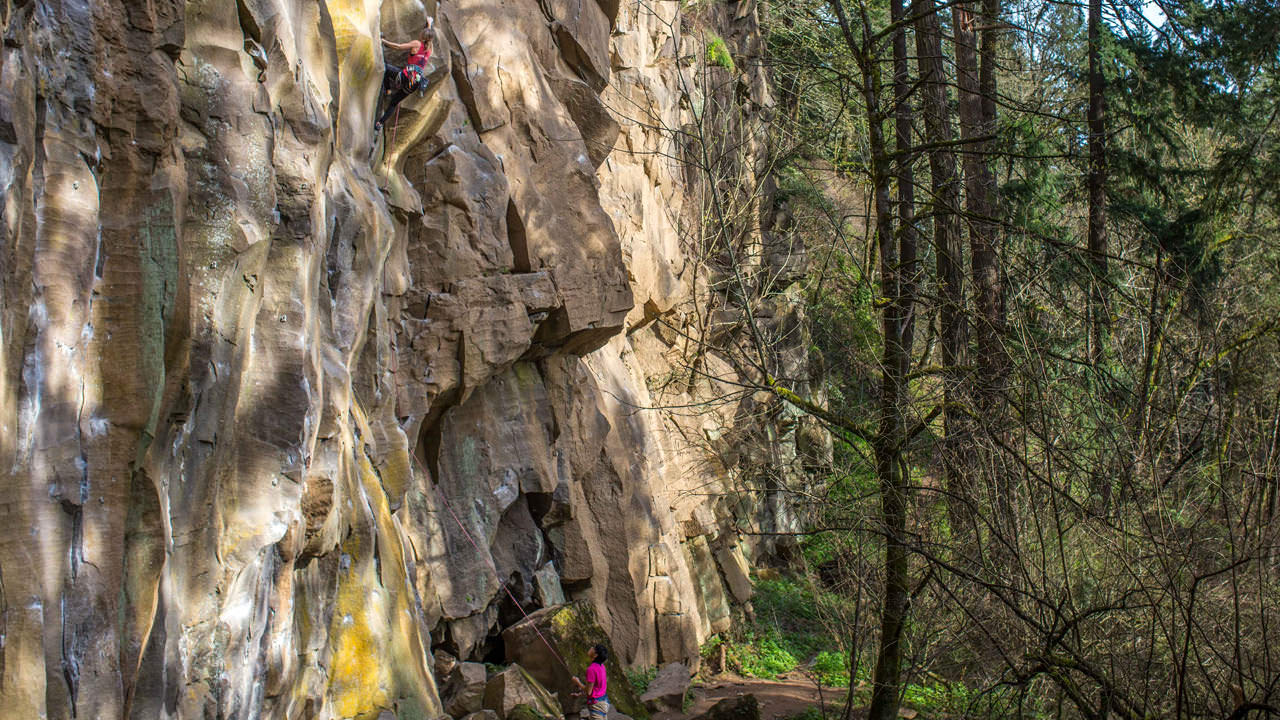
Broughton Bluff
Troutdale
Go for: Wide variety of climbs (more than 100) within a half-hour of downtown Portland.
Difficulty: Beginner to advanced.
Passes and fees: None.
Season: Year-round;best when dry.
In Lewis and Clark State Recreation Site, gateway to the Columbia River Gorge, Broughton Bluff offers over 100 climbs ranging from 5.6 to 5.13. The cliffs are mostly hidden under the tree canopy, so it remains cool and shady even on the hottest summer days. You’ll encounter a range of climbers in this local treasure, from beginners to grizzled Portland old-timers. End the outing with a dip in the nearby Sandy River and comfort food at Tad’s Chicken’n Dumplins or the Sugarpine Drive-In. For more info, go to the Portland Rock Climbs page or Portland’s Next Adventure.
Marys Peak
Corvallis Area
Go for: Friendly slab and pillar climbing with extracurricular hiking options.
Difficulty: Beginner to intermediate.
Passes and fees: Northwest Forest Pass required for parking.
Season: April to late October, depending on snow levels. (Access road closed in winter.)
Owl Slab, a short, gently sloping pitch of basalt, greets visitors at the road’s edge. Routes as easy as 5.1 make it great for beginners eager to get off the ground on a top-rope belay. Hike up to Marys Peak and search in the forest for the Druid Boulders and the five pillars, which make for longer, more vertical climbs, albeit a bit mossy. Head to Peak Sports in Corvallis for gear and info.
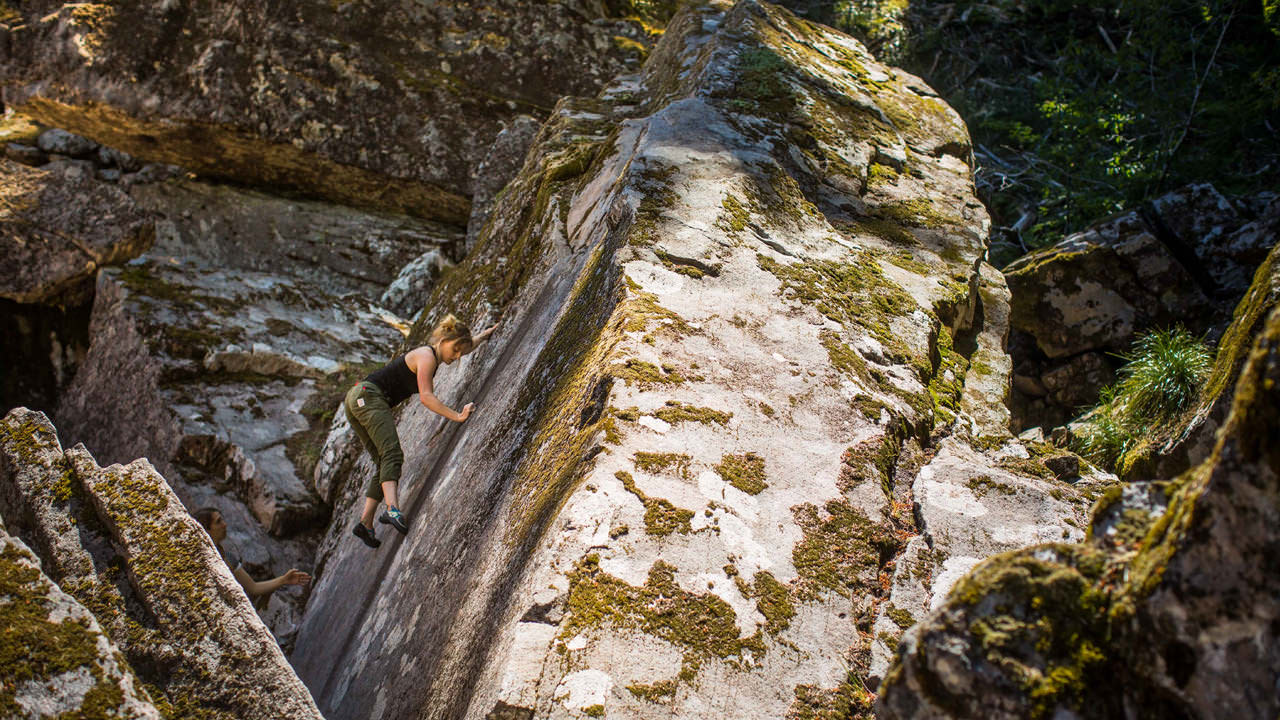
Lost Lake Boulders
Mt. Hood
Go for: Beginner-friendly bouldering near crystal-clear Lost Lake.
Difficulty: Beginner to intermediate.
Passes and fees: None.
Season: May through October, depending on snow levels.
This giant talus field holds boulders ranging in size from 6 to over 40 feet tall. It’s a jumble of angular andesitic rocks with sticky, sometimes sharp surfaces (like much of Oregon’s volcanic rock). This is a great place for beginners wanting to practice hand holds and footwork on lower-level rocks, though it also harbors some of the most challenging bouldering routes (aka “problems”) in the state. Despite its beginner appeal, care should be taken among the jumble of loose rocks and deep cracks. Find supplies and local info at Shortt Supply or 2nd Wind Sports in Hood River.
Emigrant Lake
Outside Ashland
Go for: Lakeside climbing in an oasis near I-5.
Difficulty: Mostly moderate but plenty of top-rope options.
Passes and fees: $4 day-use fee.
Season: Year-round accessibility.
This band of yellowish andesitic cliffs plunges diagonally into the green waters of Emigrant Lake. Climbs range from 30 to 80 feet and are mostly sport, with options to set up top-ropes off bolted anchors. Poison oak is rampant (the easiest of Emigrant’s three walls is named after the toxic weed) but can be avoided by walking in via the beach if water level allows. Find Mountain Provisions in Ashland for info and supplies.
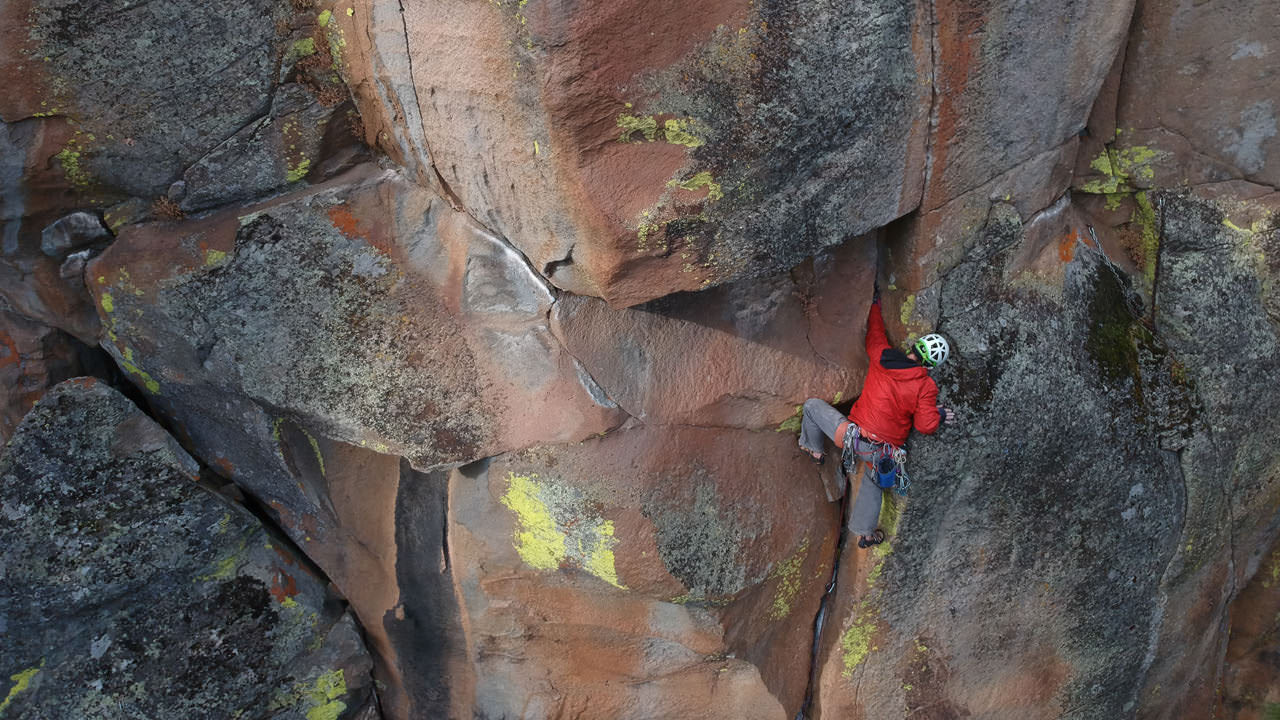
Spring Mountain
Blue Mountains, near La Grande
Go for: A wide range of climbing, great views and hiking options.
Difficulty: Beginner to intermediate sport and trad climbing.
Passes and fees: None.
Season: Mid-AprilthroughOctober, depending on snow levels.
Due to its buffet of climbing options — slabs, cracks and face climbing — this area attracts college students from Walla Walla, Washington; Pendleton and La Grande locals; and road warriors from as far as Portland. Though it’s gained popularity in recent years, largely due to its mix of sun and shade and cool elevation at 4,600 feet, Spring Mountain remains true to its quiet, unassuming Eastern Oregon roots. Check in with Blue Mountain Outfitters in La Grande for updates and info.
Climbing Etiquette
As with any other outdoor activity, climbers should practice Leave No Trace in terms of trash, gear or major signs of use. For climbers this can include chalk used to enhance finger grip on the rock. In Oregon’s porous basalt, chalk can build up in the tiny holes along routes, so many climbers bring wire brushes to clean up after themselves. Also, be wary of loose rocks when walking above climbing routes. Even a small pebble falling can be dangerous to a climber below. Find more tips on climbing etiquette here.
